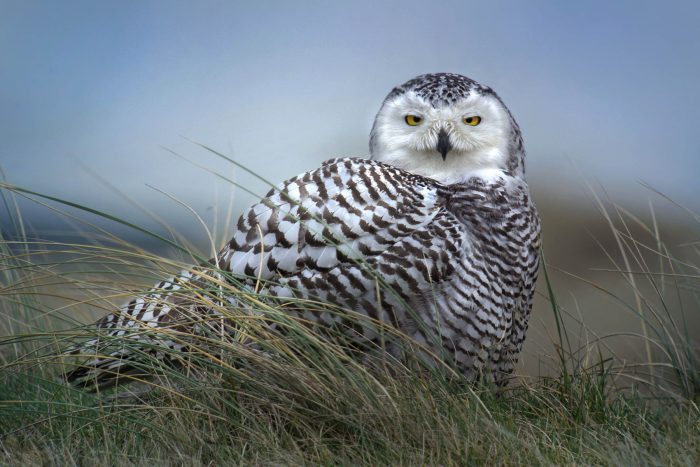Snowy Owl
Bubo scandiacus
Also known as the Arctic owl or great white owl, the snowy owl has white feathers with black and brown markings and is the largest North American owl species by weight.
This section shows one large critter image at a time. Use the thumbnails that follow to select a specific image to display here.

This gallery contains a grid of small thumbnails. Selecting a thumbnail will change the main image in the preceding section.
Appearance
Snowy owls can reach up to 27 inches in height, with a 49- to 51-inch wingspan, and can weigh between 40 and 70 ounces, making it the largest North American owl species by weight. Male snowy owls are smaller than females.
The owls have smooth, rounded heads and bulky bodies. Their feathers are white with varying degrees of black and brown markings. Females tend to have more markings, while males are a paler white. Thick feathers cover their legs and toes. A snowy owl's bill is short and sharply pointed, and its eyes are yellow, catlike and small compared to other owls.
Feeding
The snowy owl feeds on small mammals like lemmings, squirrels, voles and hares. Sometimes they eat small birds, fish and insects. Unlike most owls, snowy owls hunt during the day by sitting very still in one spot for hours. They use their impeccable senses of hearing and sight to target their prey and will swallow prey whole.
Predators
Arctic foxes, dogs, wolves and predatory birds are predators to snowy owl nests during breeding season.
Flight
These birds tend to stay close to the ground while in flight.
Voice
The low, powerful, rasping calls of the snowy owl can be heard up to seven miles away on the tundra. Hoots are given two at a time, but can include up to six in a series. When agitated, they will snap their bill and make a clacking sound.
Reproduction and life cycle
Breeding occurs between May and September. To attract a mate, the male flies into the air with prey in his bill or talons before descending to the ground, dropping the prey, lowering his head and fanning his tail as a female approaches.
The female builds its nest by scraping out a shallow hole on the ground and pairs may reuse the nest site for many years. Snowy owls will aggressively defend their nests against predators.
Three to five eggs are common when food is scarce, while seven to 11 eggs are common when food is plentiful for snowy owls. Females incubate eggs for 32 days while the male provides food for female and young. Young leave the nest about 25 days after hatching, but are not able to fly until about 50 days after hatching. Parents continue to feed their young for about 5 weeks after they leave the nest. Snowy owls can live for 10 years or more in the wild and 28 years in captivity.
Did you know?
- An adult snowy owl can eat three to five lemmings each day.
- Because snowy owls have such vast territories, it’s difficult to calculate their population size. Their breeding population is estimated to be 200,000 birds.
- During “irruptions,” where snowy owls migrate further south than normal, they can be found in the lower United States as far south as Texas and Florida.
- The most famous snowy owl that we know of is Hedwig, the letter carrier and companion of the fictional wizard Harry Potter.
